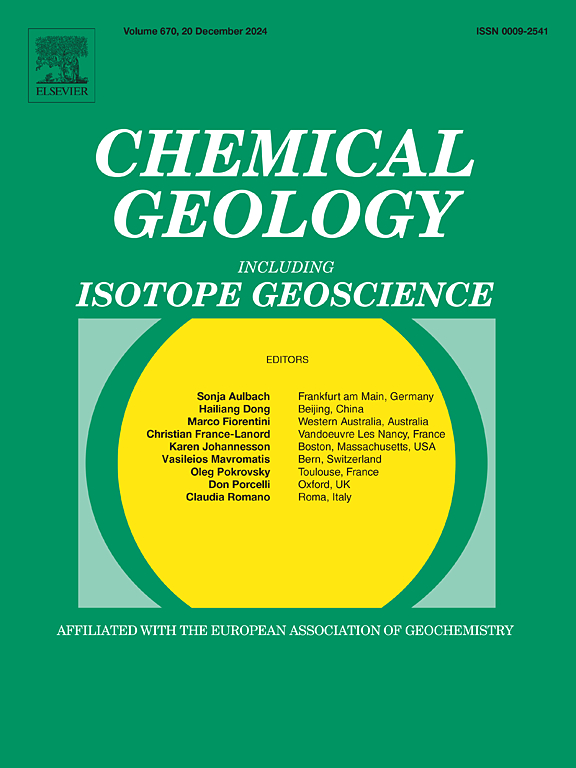陆地蜗牛体内的碳转移影响碳同位素分馏
IF 3.6
2区 地球科学
Q1 GEOCHEMISTRY & GEOPHYSICS
引用次数: 0
摘要
陆地蜗牛材料的稳定碳同位素组成(δ13C)被广泛用于重建过去的植被和环境变化。由于蜗牛生理学的复杂性,解释δ13C数据具有挑战性。本研究以 Lissachatina fulica (Bowdich, 1822) 蜗牛为研究对象,调查了其软组织和排泄物在不同植物类型和食物碳酸盐含量条件下的δ13C。结果表明,蜗牛主要同化有机物(OM),对食物中碳酸盐的利用有限。排泄物中有机物的δ13C与食物中有机物的δ13C呈正相关,但由于同化过程中碳同位素分馏的变化而出现偏差。组织δ13C(δ13Ctissue)与日粮中有机物的δ13C(δ13COM)呈正相关,因周转率而异,消化腺等周转率较快的组织δ13Ctissue值较负。此外,组织和食物之间的碳同位素分馏(Δ13Ctissue-OM)也因植物类型而异。以 C3 植物为食的蜗牛的 Δ13Ctissue-OM 值为正值,而以 C4 植物为食的蜗牛的 Δ13Ctissue-OM 值为负值。这些Δ13Ctissue-OM值与蜗牛快速生长条件下的平衡值(Δ13Ctissue-OM = 0)相去甚远。我们的研究结果表明,用 C3 和 C4 植物喂养蜗牛会导致不同的碳同位素分馏,从而导致植物和陆地蜗牛物质(如排泄物、组织、壳和壳结合有机物)之间的 Δ13C 偏差。研究提出了蜗牛碳代谢和同位素分馏的综合模型,包括从食物到软组织和排泄物的同化过程。该研究强调了在解释陆地蜗牛材料的δ13C时,生长率和周转率等生理因素对古环境重建的重要性。本文章由计算机程序翻译,如有差异,请以英文原文为准。
Carbon translocation within land snails affects the carbon isotopic fractionation
Stable carbon isotope composition (δ13C) of land snail materials is widely used as a proxy for reconstructing past vegetation and environmental changes. Interpretation δ13C data is challenging due to the complexities of snail physiology. This study cultured Lissachatina fulica (Bowdich, 1822) snails to investigate δ13C of their soft tissues and excrement under various plant types and dietary carbonate content. Our results show that snails primarily assimilate organic matter (OM), with limited use of dietary carbonates. δ13C of organic matter in excrement correlates positively with that in the diet, but exhibits deviations due to variable carbon isotopic fractionation during assimilation. Tissue δ13C (δ13Ctissue) is positively related to the δ13C of OM (δ13COM) in the diet, varying by turnover rates, with faster turnover rate, such as the digestive gland, exhibiting more negative δ13Ctissue values. Moreover, carbon isotopic fractionation between tissues and diet (Δ13Ctissue-OM) differs based on plant type. Snails fed with C3 plants show positive Δ13Ctissue-OM values, whereas those fed with C4 plants exhibit negative values. These Δ13Ctissue-OM values are far from equilibrium (Δ13Ctissue-OM = 0) with conditions of rapid snail growth. Our findings indicate that the snails fed with C3 and C4 plants result in distinct carbon isotopic fractionation, leading to the deviation in δ13C between plants and land snail materials (e.g., excrement, tissues, shells and shell-bound organic matter). A comprehensive model of carbon metabolism and isotopic fractionation in snails is proposed including the assimilation process from diet to soft tissues and excretion. This study highlights the importance of physiological factors such as growth rates and turnover rates when interpreting δ13C of land snail materials for paleoenvironmental reconstructions.
求助全文
通过发布文献求助,成功后即可免费获取论文全文。
去求助
来源期刊

Chemical Geology
地学-地球化学与地球物理
CiteScore
7.20
自引率
10.30%
发文量
374
审稿时长
3.6 months
期刊介绍:
Chemical Geology is an international journal that publishes original research papers on isotopic and elemental geochemistry, geochronology and cosmochemistry.
The Journal focuses on chemical processes in igneous, metamorphic, and sedimentary petrology, low- and high-temperature aqueous solutions, biogeochemistry, the environment and cosmochemistry.
Papers that are field, experimentally, or computationally based are appropriate if they are of broad international interest. The Journal generally does not publish papers that are primarily of regional or local interest, or which are primarily focused on remediation and applied geochemistry.
The Journal also welcomes innovative papers dealing with significant analytical advances that are of wide interest in the community and extend significantly beyond the scope of what would be included in the methods section of a standard research paper.
 求助内容:
求助内容: 应助结果提醒方式:
应助结果提醒方式:


